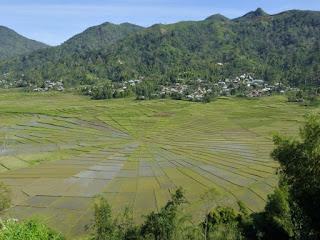By, Febri Wengke
Manggarai is one of the tribes that found in Indonesia. Precisely in the eastern part of Indonesia, namely the island of Flores which as part of the East Nusa Tenggara Province. The Manggarai tribe is particular in the western part of Flores island, where the government system is dividing into three districts including West Manggarai, Central Manggarai(Manggarai), and East Manggarai. The inheritance of Manggarai’s land makes it different from other areas in Flores Island. Due to the fertility of Manggarai soil, most of the people hold on to their livelihoods as farmers. Therefore, from their ancestor until now the Manggarai area is the only area that has applied the Lingko Tradition to their plantation areas. The tradition of Lingko by the ancestor of the Manggarai community is believed to be a system of equitable distribution of plantation land, which the Manggarai community applies to wet plantation areas (rice field) and to dry plantations.
Lingko is a tradition of the Manggarai community in general as terms of forming wet and dry plantation areas. This is Lingko tradition with forming of the circle plantation that looks like spider web. Lingko has centered at the central point that named “Lodok” and it has border outside as named “Cicing”. From the ancestor until now the Manggarai communities believe that with the Lingko system to their plantation as the equitable system. As the implementation of the Manggarai term is “Gendang One Lingko Pe’ang”, which is ‘Gendang” as the traditional house of Manggarai community that can be lived together and “Lingko” itself as the plantation area that can be possessed by together of community in one village “beo/golo”. One of the rice field plantation area that applied Lingko system is Cancar rice field plantation, located in Manggarai Regency which because the uniqueness of Lingko, it become well known in world. In Cancar rice field plantation has some of the Lingko such as; Lingko Molo, Lingko Meler, Lingko Ndung, Lingko Lindang, Lingko Temek, Lingko Purang Pane, Lingko Sepe, and Lingko Wae Toso. From the stretch of the Lingko, the goverment has made the Lingko rice fields a tourist attraction because of its uniqueness which resembles a spider_web.
The tradition of Lingko to dividing land as the trusted of Manggarai community since the ancestor lived in Manggarai which the Lingko distribute from central or central dividing as named Lodok. At the central of Lodok have to perform a traditional ceremony namely ‘Tente’ as before the rice field distribute. The Tente ceremony is the praying and offering to the ancestor as to thanks giving and ask the blessing to the creation of Lingko. On the ceremony of Tente was done by offerings the slaughtering as one of the sacrificial animals, like goats and chickens. After the thanks giving and offerings ceremony, the Teno wood ‘haju teno’ was planted at the central Lodok which has been proved. Then with the Moso formula or finger formula which to dividing the field on Lingko has made with pull the ‘wase’ or rope that has been tied to the teno wood, pull the rope from the center to the ‘cicing’ or outer boundary of Lingko. Field that on the Lingko divided based on the number of families or ‘Wa’u’ who live in one ‘beo’ or village. Even so in the division of fields in one Lingko through customs which get the largest share of the fields are Tu’a Teno and Tu’a Golo. As for people from other village ‘beo’ who want to obtain one fields in Lingko with customary condition through requests to Tu’a Golo and Tu’a Teno and offering a rooster and typical Manggarai drink ‘tuak’ which is in the Manggarai term is “kapu manuk lele tuak” then do the meeting according to the custom. The ones who have the authority to lead the division process in the Lingko are Tu’a Golo as the head of customary in one village and Tu’a Teno as the head of the land management division for the villagers. In which Tu’a Golo and Tu’a Teno have been chosen based on deliberation with the term ‘lonto leok’ in the customary system of one village since ‘hese beo’ or when the village was founded, then the position continues to be passed down on to their children and grandchildren.
From the way of Manggarai people life that most of the people hold on agricultural aspect as the way to continuing the life. Therefore, agricultural areas are urgently needed, which is also highly supported by fertile conditions of the Manggarai area and very suitable for farming. Thus from their ancestor until now the Lingko tradition has been preserved when the Manggarai people want to open new land. On the Lingko plantation system by the Manggarai community believe that representation of equal life in togetherness as the Manggarai people who lived in one village ‘beo’/’golo’. Moreover the Lingko tradition applied on Manggarai people’s plantation. As the form of stability to maintain kinship relations because they have part of the fields in the same Lingko.
References
Flores Magazine, 2013
https://www.manggaraikab.go.id/berita.phd?read=730
www.kompasiana.com/mengenal-sawah-laba-laba-di-kampung-meler





Tidak ada komentar:
Posting Komentar